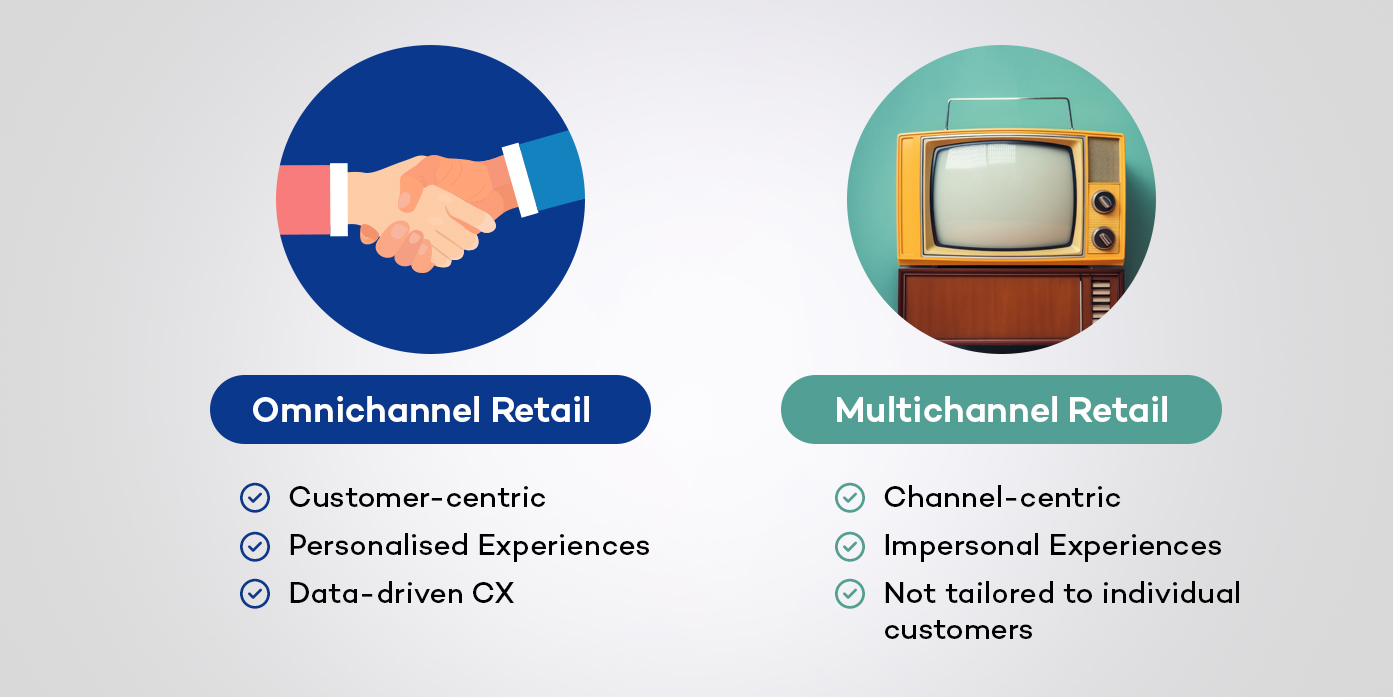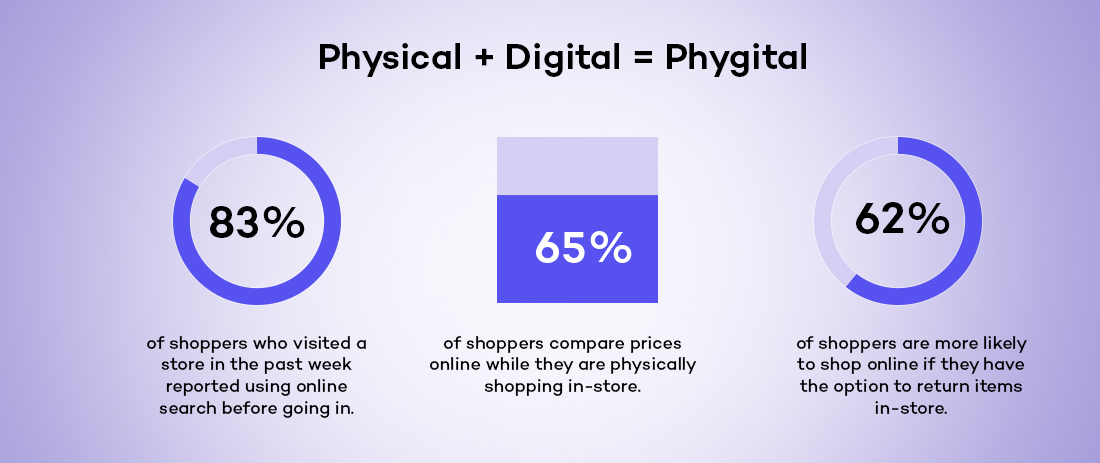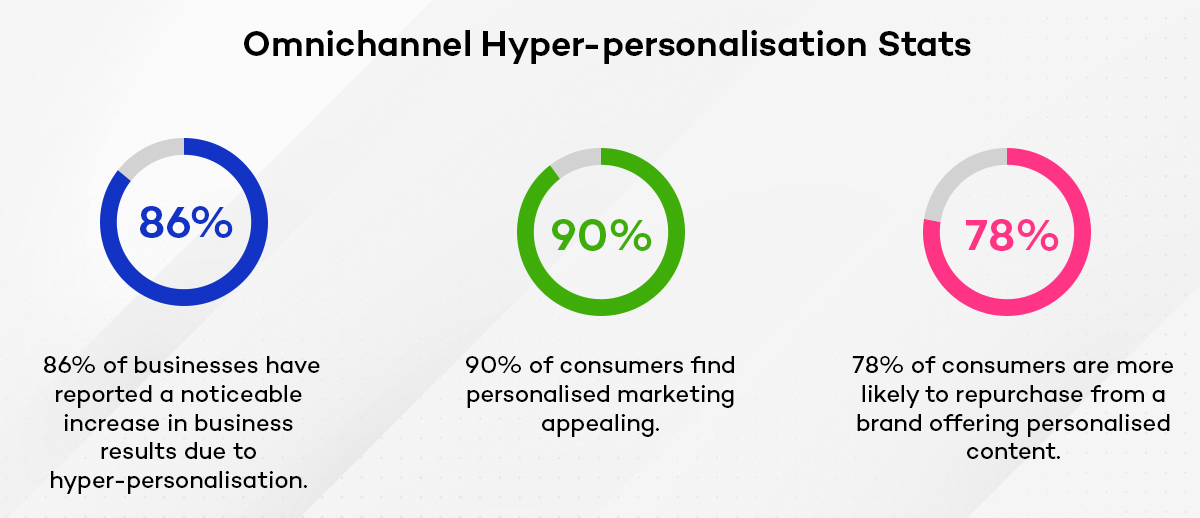Nowadays, with everything going digital, shoppers want a smooth shopping journey that mixes both online and offline worlds perfectly. That's where the idea of omnichannel retail steps in. It's all about making sure customers get a uniform and tailored experience no matter how they choose to shop - be it visiting an actual store, checking out stuff on websites, scrolling through social media or using a mobile app.
Moreover, understanding the entire customer journey and addressing needs at every touchpoint can lead to increased satisfaction, higher sales, and improved customer loyalty. The key lies in leveraging technology to customise the shopping journey, offering personalised content and promotions. Mastering omnichannel strategies positions retailers to excel in the future retail landscape.

Fig. Transformation from Omnichannel Retail to Multichannel Retail
Milestones in the Growth of Omnichannel Retailing
- Online Shopping Boom: The rise of ecommerce introduced numerous shopping channels, paving the way for omnichannel retailing.
- Mobile Devices & Smartphones: These devices revolutionised customer-brand interactions, facilitating diverse omnichannel experiences.
- Social Media Engagement: Retailers leveraged social platforms to connect with customers, ensuring seamless experiences across online and offline interactions.
- AI and Machine Learning: Advanced technologies enabled personalised shopping experiences through tailored content and promotions.
- COVID-19 Pandemic: The pandemic accelerated the adoption of omnichannel strategies, emphasising contactless shopping and blending online presence with physical stores.
Key Omnichannel eCommerce Trends to Watch Out For!
#1 Phygital Experience
Retailers no longer have to choose between ecommerce and brick-and-mortar stores, thanks to the omnichannel business model. Brands that started online are now opening physical stores to enhance customer experience and streamline shopping journeys. While online shopping is convenient, physical stores allow customers to see, touch, and interact with products and staff, deepening their connection to the brand.
| According to Census.gov, ecommerce sales in the U.S. account for just 15.4% of total retail sales, with the majority of shopping still occurring in physical stores. |
Establishing physical locations helps brands lower consumer acquisition costs by building stronger relationships and showcasing products in ways that online platforms can't match. Engaging displays and personalised service enhance the customer experience, creating a seamless journey whether online or in-store.
By blending online and offline channels, brands can offer a holistic, cost-effective shopping experience that boosts customer loyalty and reduces acquisition costs. This trend underscores the power of a unified omnichannel strategy in today’s retail landscape.
#2 Embracing an Omnichannel Consumer Journey
Nowadays, when people decide to buy something, their journey isn't just a straight line from getting to know about the product to buying it; customers touch base with brands in many ways before they make a purchase. For example, someone might start by looking at products on a mobile app, do more digging on a website later on, and then either buy the thing in an actual store or online.
To keep up with these changes in how people shop, stores need to offer an omnichannel experience that makes it easy for customers to switch between different channels without any hassle. This means everything - like how things look (branding), details about products (product information), and help from the company (customer service) - needs to be consistent no matter where or how you're shopping.
Approximately 66% of Home Depot’s customers utilise the Buy Online, Pick Up In Store (BOPIS) option, which has significantly driven in-store revenue, according to Igor Cherny, the former VP of Online, Marketing, and Merchandising Technology at Home Depot.
| BOPIS Fact: 68% of consumers have made multiple purchases using Buy Online, Pick Up In Store (BOPIS). |
| BORIS FACT: At least 30% of products ordered online are returned, compared to just 8.89% of items purchased in brick-and-mortar stores. |
Understanding this whole process of shopping across various platforms and making sure shoppers have a smooth ride can really help stores get more love from their customers, boost sales, and earn loyal fans.

#3 Retail Store Associates Embrace Omnichannel Roles
Retail store workers aren't just there to sell things anymore. They're key in making sure customers have a smooth experience, no matter how they choose to shop. These days, it's important for them to know their way around not only the physical store but also online stuff like social media and everything else that makes up the brand's whole game plan. They help folks find what they need, answer questions about deals you might see online, and suggest products based on what you've looked at before.
| 71% of consumers feel frustrated when their shopping experience lacks personalisation. |
This means that whether a customer is scheduling a personal shopping session online or exploring products virtually, retail staff are equipped to make their shopping journey feel special and customised. Talking again about Home Depot, it saw a 238% increase in engagement through personalised data. Can you imagine what personalisation can do to your brand?
#4 Offline Application of Customer Data Insights
Understanding what customers like and how they shop isn't just useful for online shops but also for the traditional stores buyers visit. By digging into customer data, store owners can figure out what shoppers prefer, how they behave, and what they often buy. This information helps improve shopping in physical stores and keeps customers returning.
| 62% of retailers say they have a competitive edge thanks to data analytics and information. |
Here are some ways to use this info in real-life stores:
- Making the shopping experience personal by using what a customer has looked at online.
- Giving special deals or discounts based on what someone has bought before.
- Teaching staff to give recommendations that fit with what we know about a customer's likes.
- Arranging the store and where products go in a way that makes shopping smoother and more fun.
#5 Leveraging Video Content for Social Selling
Nowadays, social media is a big deal for stores looking to reach out to people and boost their sales. A cool trend catching on in the world of online shopping is using videos to sell stuff. By making fun and helpful videos, shops can show off what they're selling, teach folks how to use it, and chat with them in a way that's more lively.
| Sales professionals who engage in social selling close 40-50% more new business compared to those who do not. |
Let’s talk about how Burberry is nailing the social selling trend! Burberry created captivating and emotionally engaging content that highlighted its products, heritage, and brand values, effectively connecting with its audience. By actively interacting through comments, direct messages, and leveraging user-generated content, Burberry nurtured a strong sense of community and loyalty among its social media followers.
This strategy has resulted in impressive growth, with the brand amassing 17 million Facebook fans and 3.01 million Twitter followers. Popular hashtags like #ThisIsBrit further amplify their reach and engagement, solidifying Burberry’s presence and influence in the digital space.
Here are some smart ways how you can utilise video content for social selling as well:
- Making quick demos or "unboxing" clips that highlight what's great about your products.
- Going live to do Q&A sessions or how-tos so you can answer questions and give tips like pros.
- Teaming up with popular influencers or brand fans who help make genuine content that grabs attention.
- Sharing videos made by customers themselves showing off how much they love using the products.

#6 Unified Commerce: One Cart, Endless Aisles
Unified commerce is taking omnichannel commerce to the next level. How? Unified commerce is a more holistic approach to retail, seamlessly putting together to enhance customer shopping journeys. Unified commerce offers a comprehensive view of consumers on the back end, enabling the creation of seamless and integrated experiences on the front end, no matter where or how the purchase journey unfolds. One can say, unified commerce allows businesses to provide one cart with endless aisles to their customers.
| Retail stores lose approximately 10% of their sales due to items being out of stock. |
With just one cart, shoppers can pick up items and switch between shopping online or in person without any hiccups. Now buyers have the chance to browse through loads of products everywhere - be it online or at a physical store - so finding what they want is easy-peasy.

Conclusion
Omnichannel retail is the present, and its future is promising as well. As consumer expectations continue to evolve, the need for a seamless and integrated shopping experience becomes even more critical. By embracing omnichannel trends and tendencies, retailers can ensure that every customer interaction, whether online or offline, is cohesive and personalised. This approach not only enhances customer satisfaction but also drives brand loyalty and boosts sales.
Retailers who invest in omnichannel solutions will be better positioned to navigate the complexities of modern retail and meet the diverse needs of their customers. With advancements in technology, such as unified commerce and data-driven insights, the future of omnichannel retail is set to offer even more dynamic and engaging experiences. As we move forward, the ability to blend online and offline channels effortlessly will be key to staying competitive and thriving in the ever-evolving retail landscape.







.png?h=250&fm=webp)
.png?h=250&fm=webp)
.png?h=250&fm=webp)



.png?h=250&fm=webp)
.png?h=250&fm=webp)
.png?h=250&fm=webp)


.png?h=250&fm=webp)



.png?h=250&fm=webp)
















.png?h=250&fm=webp)

.png?h=250&fm=webp)
.png?h=250&fm=webp)



































































































































.png?h=250&fm=webp)


.jpg?h=250&fm=webp)





 copy.png?h=250&fm=webp)























_ Why do you need one.png?h=250&fm=webp)


























































.jpg?h=250&fm=webp)

.png?h=250&fm=webp)



.png?h=250&fm=webp)

.jpg?h=250&fm=webp)




.png?h=250&fm=webp)









.jpg?h=250&fm=webp)
